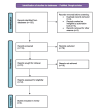Role of Platelet-Rich Plasma in Genitourinary Syndrome of Menopause
- PMID: 38435897
- PMCID: PMC10906939
- DOI: 10.7759/cureus.53316
Role of Platelet-Rich Plasma in Genitourinary Syndrome of Menopause
Abstract
The genitourinary syndrome of menopause (GSM) encompasses a range of symptoms linked to the genitourinary tract stemming from the reduction in estrogen levels following menopause. These symptoms may endure throughout a woman's lifetime. Platelet-rich plasma (PRP), known for its capacity to induce angiogenesis and the restoration effects of growth factors, has been widely employed in various disorders, including GSM. This article aims to comprehensively review the existing literature on the utilization of PRP for managing GSM. The search was executed in electronic databases, specifically PubMed, Scopus, and Google Scholar, up until April 2023. Eligible studies were meticulously chosen for inclusion in this systematic review. PRP emerges as a viable alternative for addressing vaginal atrophy, exhibiting favorable outcomes. Notably, it can be considered for patients with contraindications to hormonal therapy. However, the available body of evidence supporting the use of PRP for GSM remains limited. PRP presents itself as a promising agent, offering a patient-friendly, cost-effective alternative modality. To establish the efficacy of PRP in treating GSM definitively, future randomized trials are imperative.
Keywords: genitourinary syndrome of menopause (gsm); hyaluronic acid (ha); photodynamic therapy (pdt); platelet rich plasma (ppp); vascular endothelial growth factor (vegf).
Copyright © 2024, Waghe et al.
Conflict of interest statement
The authors have declared that no competing interests exist.
Figures
Similar articles
-
Injection Treatments for Vulvovaginal Atrophy of Menopause: A Systematic Review.Aesthetic Plast Surg. 2023 Dec;47(6):2788-2799. doi: 10.1007/s00266-023-03550-5. Epub 2023 Aug 14. Aesthetic Plast Surg. 2023. PMID: 37580562
-
Genitourinary syndrome of menopause: a systematic review on prevalence and treatment.Menopause. 2021 Mar 15;28(6):706-716. doi: 10.1097/GME.0000000000001752. Menopause. 2021. PMID: 33739315
-
The 2020 genitourinary syndrome of menopause position statement of The North American Menopause Society.Menopause. 2020 Sep;27(9):976-992. doi: 10.1097/GME.0000000000001609. Menopause. 2020. PMID: 32852449
-
Use of a vaginal CO2 laser for the management of genitourinary syndrome of menopause in gynecological cancer survivors: a systematic review.Climacteric. 2022 Jun;25(3):228-234. doi: 10.1080/13697137.2021.1990258. Epub 2021 Oct 25. Climacteric. 2022. PMID: 34694948
-
Management of genitourinary syndrome of menopause in women with or at high risk for breast cancer: consensus recommendations from The North American Menopause Society and The International Society for the Study of Women's Sexual Health.Menopause. 2018 Jun;25(6):596-608. doi: 10.1097/GME.0000000000001121. Menopause. 2018. PMID: 29762200
Cited by
-
Sexual Quality of Life in Postmenopausal Women: A Comparative Randomized Controlled Trial of Intravaginal PRP Therapy Versus Local Hormonal Treatments.Medicina (Kaunas). 2025 Jun 25;61(7):1140. doi: 10.3390/medicina61071140. Medicina (Kaunas). 2025. PMID: 40731770 Free PMC article. Clinical Trial.
References
-
- Genitourinary syndrome of menopause: new terminology for vulvovaginal atrophy from the International Society for the Study of Women's Sexual Health and the North American Menopause Society. Portman DJ, Gass ML. Menopause. 2014;21:1063–1068. - PubMed
-
- Genitourinary syndrome of menopause: management strategies for the clinician. Faubion SS, Sood R, Kapoor E. Mayo Clin Proc. 2017;92:1842–1849. - PubMed
-
- ACOG practice bulletin no. 141: management of menopausal symptoms. Obstet Gynecol. 2014;123:202–216. - PubMed
-
- Genitourinary syndrome of menopause. Farrell Am E. https://pubmed.ncbi.nlm.nih.gov/28697291/ Aust Fam Physician. 2017;46:481–484. - PubMed
-
- Genitourinary syndrome of menopause: an overview of clinical manifestations, pathophysiology, etiology, evaluation, and management. Gandhi J, Chen A, Dagur G, Suh Y, Smith N, Cali B, Khan SA. Am J Obstet Gynecol. 2016;215:704–711. - PubMed
Publication types
LinkOut - more resources
Full Text Sources
Research Materials
Miscellaneous

